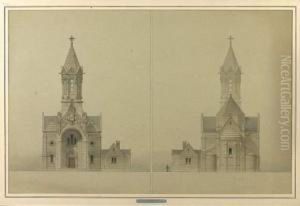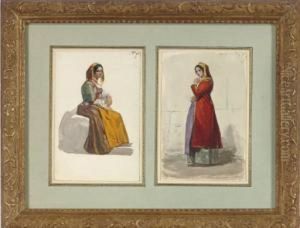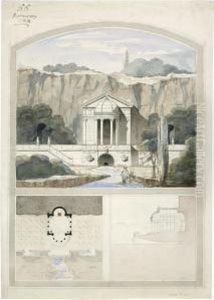Alfred Vaudoyer Paintings
Alfred Louis Paul Vaudoyer, born in 1846, was a distinguished French architect whose contributions spanned the late 19th and early 20th centuries. He was born into a family with a rich legacy in architecture, being the grandson of Antoine-Laurent-Thomas Vaudoyer, a prominent architect of the neoclassical movement. This lineage provided Alfred Vaudoyer not only with a prestigious name but also with a profound architectural heritage that influenced his career path from an early age. Vaudoyer's education and professional development were deeply rooted in this familial and cultural background, which set the stage for his contributions to French architecture.
Throughout his career, Alfred Vaudoyer worked on a variety of projects, including public buildings, religious structures, and urban planning initiatives. His architectural style was characterized by a blend of traditional and innovative elements, reflecting the transitional period of architecture during his lifetime. Vaudoyer's work embodied the principles of Beaux-Arts architecture, a style that emphasized classical forms, symmetry, and elaborate detailing. This approach made him a key figure in the architectural scene of his time, bridging the gap between the historical grandeur of classical architecture and the emerging trends of the modern era.
Notably, Alfred Vaudoyer's contributions extended beyond his architectural creations. He was also involved in architectural education, teaching at the École des Beaux-Arts in Paris, one of the most prestigious art and architecture schools in the world. His influence as an educator helped shape the next generation of architects, spreading his architectural philosophy and style through his students. Vaudoyer's legacy is not just in the buildings he designed but also in the impact he had on the architectural community through his teaching and mentorship.
Alfred Louis Paul Vaudoyer passed away in 1917, leaving behind a legacy that had significantly impacted French architecture. His works continue to be studied and admired for their artistic and historical significance, showcasing the talent and vision of an architect who adeptly navigated the changing landscape of his time. Vaudoyer's life and career exemplify the rich tradition of French architecture and its evolution over the late 19th and early 20th centuries, marking him as a notable figure in the annals of architectural history.


